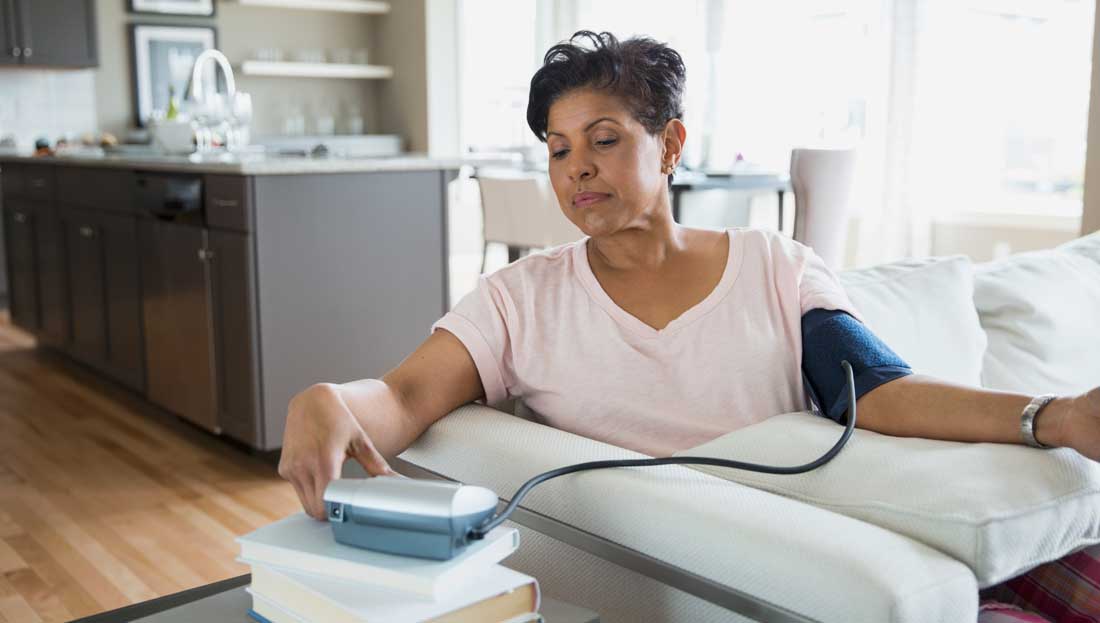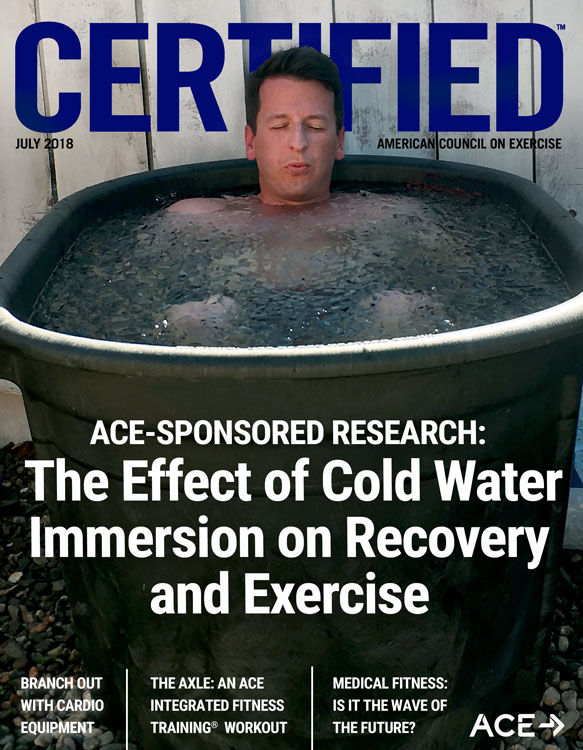
In 2017, the American College of Cardiology (ACC) and the American Heart Association (AHA) released new guidelines for defining and managing hypertension (Whelton et al., 2017). Prior to the publication of these guidelines, hypertension was defined as a blood pressure greater than 140/90 mmHg. When using that threshold, 32% of the American population had hypertension.
Now, with the publication of the new ACC/AHA guidelines, anyone with a blood pressure greater than 130/80 mmHg—approximately 103 million individuals—is considered to have hypertension (Table 1). Also new with this update is the fact that the prehypertension category—previously defined as a blood pressure of 120–139/80–89 mmHg—has been deleted entirely. So, what does this mean to you as a health coach or exercise professional?

It’s important that all health coaches and exercise professionals educate themselves about the changes, as the newly lowered threshold means that an additional 14% of Americans find themselves having hypertension overnight. That will likely lead to a number of questions from clients, some of whom may scoff at the change and their new status as a person with hypertension, and others of whom may be worried that they’ve been ignoring a serious health concern. Many people’s first response may be to chalk the changes up to an overreaching pharmaceutical industry trying to sell more medications or drive more people to their doctors and into the healthcare industry.
Another troubling possibility that comes with the lowering of the hypertension threshold is that people may begin to believe that hypertension is not a major concern: “It seems like everyone has hypertension, so what’s the big deal?” The last thing that health coaches and exercise professionals should want for their clients is a resigned acceptance of chronic illness and a reduced quality of life. Clients considering chronic diseases like obesity, hypertension and diabetes to be commonplace and “no big deal”—consider the millions of Americans taking medications to manage pain or chewing antacids after every meal as though doing so is a reasonable means of coping with illness or injury—is something that must be guarded against.
In addition, holding any of these cynical viewpoints is to ignore the nuance in the ACC/AHA paper, which emphasizes a shift from treatment to prevention.
A Focus on Lifestyle Change
The vast majority of that newly diagnosed 14% will not need to be medicated. According to Whelton et al. (2017), “The new definition of high blood pressure results in more people being actively counseled on lifestyle changes to reduce blood pressure but only a small increase in the percentage of U.S. adults for whom antihypertensive medication is recommended in conjunction with lifestyle management.”
The guidelines suggest treatment through lifestyle change in an effort to prevent a person’s blood pressure from increasing to the point where medication is necessary. By diagnosing people earlier, the hope is that they will become more likely to follow their doctors’ advice to live a healthier lifestyle. As stated by Whelton et al. (2017), “People with elevated or stage 1 hypertension should be counseled to make lifestyle changes that can help reduce their blood pressure. These include engaging in physical activity on most days of the week, losing weight, reducing salt and quitting smoking.”
And this is where you come in.
Lifestyle change in an effort to prevent a worsening of hypertension will require three things to be effective: (1) doctors who are willing and able to prescribe behavior change to their patients (eating a healthier diet, performing more physical activity, quitting smoking, improving the quantity or quality of sleep, reducing stress and so on), (2) patients who heed this advice and seek out lifestyle-change programs and (3) qualified health coaches and exercise professionals to lead those programs. According to Cedric X. Bryant, Ph.D., ACE Chief Science Officer, “This represents a tremendous opportunity for ACE Certified Professionals, who are perfectly positioned to take advantage of a moment when more and more people will be seeking their expertise and services.”
Earlier intervention—through lifestyle change and, for some, the use of medication—is much more likely when people are diagnosed with elevated blood pressure at the new, lower threshold (see Table 1). Such interventions lead to reductions in the risk of heart attack, stroke and other consequences of high blood pressure. Note that these risks double when a person’s systolic blood pressure is 130 mmHg, as compared to 120 mmHg. When discussing this with clients, be sure to focus on the positive talk about the importance of lifestyle change—a process they have already begun by seeking out your services.
It is essential that all health coaches and exercise professionals follow the guidance of each client’s physician, as lifestyle change, no matter how effective, is not always enough to manage hypertension. As the focus of the new guidelines is on lifestyle change, clinicians are urged to prescribe medication for individuals with stage 1 hypertension only if they already have had a cardiovascular event, are at an elevated risk of stroke or heart attack, or have diabetes, chronic kidney disease or atherosclerotic risk. The important thing here is that making that decision is well outside your scope of practice as a health coach or exercise professional, so it is essential that you follow the direction of each client’s healthcare provider.
In Conclusion
The goal of the update from the ACC and AHA is to promote early intervention and an ongoing emphasis on lifestyle change for those with hypertension, no matter what the stage, in an effort to reduce further increases in blood pressure and avoid associated comorbidities. From the perspective of health coaches and exercise professionals, it is encouraging to see such a strong call to action that emphasizes lifestyle change rather than a reliance on medication.
This represents an opportunity not only to better serve existing and potential clients, but also to work in concert with the healthcare community to improve the quality of life of individuals with hypertension. The shift in the blood pressure guidelines is just one more reason why health coaches and exercise professionals are essential members of each client’s healthcare team.
A Recent Controversy over Type 2 Diabetes Guidelines
The American Diabetes Association (ADA) and the American College of Physicians (ACP) recently found themselves at odds when it came to the appropriate hemoglobin A1C target for people with type 2 diabetes. (Note: Hemoglobin A1C is a key indicator of long-term blood glucose control.)
The ADA has long recommended that treatment goals be individualized based on factors such as age, life expectancy, how long the person has had type 2 diabetes, comorbid conditions, and resources and support, but state that an A1C goal of 7% (anyone with an A1C level above 6.5% is considered to have diabetes) is reasonable for most nonpregnant adults (ADA, 2018a).
The ACP recently published its own set of guidelines recommending a less aggressive target A1C between 7 and 8%, stating that the benefits of further reductions do not result in reduced death or macrovascular events for those with type 2 diabetes (Qaseem et al., 2018). Furthermore, the ACP states that there are potential hypoglycemia-related risks associated with the more aggressive target and treatments.
The ADA responded by saying they are “deeply concerned” with these new guidelines (ADA, 2018b), and that the ACP’s guidance does not consider the positive effects of intensive blood glucose control and, therefore, does not reflect the long-term benefits of lower A1C targets. The ADA states that there is clear and convincing evidence of long-term reductions in diabetes-related complications with A1C levels at and below 7%.
So, what does this mean to health coaches and exercise professionals?
While it is important to be aware of controversies like this in case a client has questions, it is well outside your defined scope of practice to set A1C targets. This is the responsibility of the client’s physician. Your role is to help the client achieve whatever goal has been established by the client’s healthcare provider through lifestyle and behavior change, and that role remains the same regardless of the client’s target.
References
American Diabetes Association (2018a). Standards of medical care in diabetes—2018. Diabetes Care, 41, Supplement 1.
American Diabetes Association (2018b). American Diabetes Association Deeply Concerned About New Guidance from American College of Physicians Regarding Blood Glucose Targets for People with Type 2 Diabetes.
Qaseem, A. et al. (2018). Hemoglobin A1C targets for glycemic control with pharmacologic therapy for nonpregnant adults with type 2 diabetes mellitus: A guidance statement update from the American College of Physicians. Annals of Internal Medicine, 168, 8, 569-576.
Whelton, P.K. et al. (2017). 2017 ACC/AHA/AAPA/ABC/ACPM/AGS/APhA/ASH/ASPC/NMA/PCNA guideline for the prevention, detection, evaluation and management of high blood pressure in adults: A report of the American College of Cardiology/American Heart Association Task Force on Clinical Practice Guidelines. Journal of the American College of Cardiology, Nov 7. pii: S0735-1097 (17) 41519-1.





 by
by 



